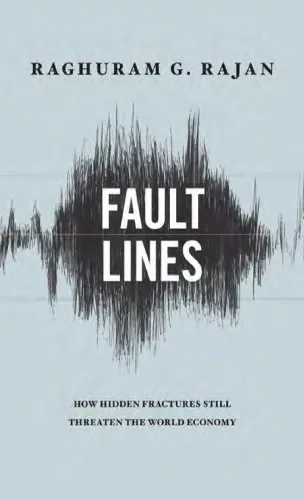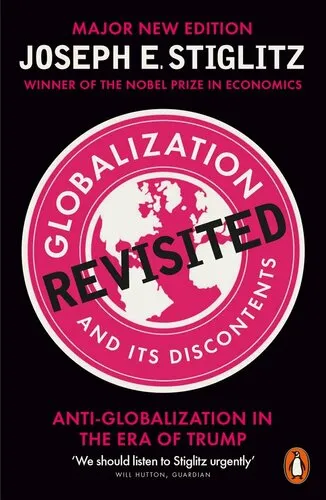Fault Lines: How Hidden Fractures Still Threaten the World Economy
4.5
بر اساس نظر کاربران

شما میتونید سوالاتتون در باره کتاب رو از هوش مصنوعیش بعد از ورود بپرسید
هر دانلود یا پرسش از هوش مصنوعی 2 امتیاز لازم دارد، برای بدست آوردن امتیاز رایگان، به صفحه ی راهنمای امتیازات سر بزنید و یک سری کار ارزشمند انجام بدینکتاب های مرتبط:
کتاب 'Fault Lines: How Hidden Fractures Still Threaten the World Economy' نوشته راگهورام جی. راجان، یکی از برجستهترین آثار در زمینه اقتصاد جهانی و تحلیل علل بحرانهای مالی است. این کتاب با نگاهی ژرف و تحلیلی، به بررسی شکافها و نقاط ضعفی میپردازد که در بطن نظام مالی جهانی نهفتهاند و چگونه این شکافها همچنان تهدیدی برای اقتصاد جهانی محسوب میشوند.
خلاصهای جامع از کتاب
کتاب 'Fault Lines' به بررسی ریشههای بحران مالی جهانی در سال 2008 و عوامل اصلی آن میپردازد. راجان معتقد است که این بحرانها نه تنها به علت خواستهای نهادی و اقتصادی در کشورهای توسعهیافته مانند ایالات متحده، بلکه به سبب شکافهای عمیقتر در اقتصاد جهانی رخ داد. او به تحلیل دقیق وابستگی اقتصاد جهانی به تقاضای مصرفکننده در اقتصادهای پیشرفته، فقدان نظارتهای موثر و دیگر نواقص میپردازد که به شکلگیری بحرانهای مالی کمک کردهاند.
از منظر نویسنده، سیاستهای نامتعادل اقتصادی، نابرابری درآمدها، و عدم تطابق در سیاستهای پولی و مالی کشورها موجب شدهاند که این شکافها به بحرانهای جدی تبدیل شوند. راجان همچنین به تاثیر سیاستهای دولتها و بازیگران کلیدی در تجارت و نحوهٔ تاثیر آنها بر اقتصاد جهانی پرداخته و نقاط ضعف و قدرت این ساختارها را تحلیل میکند.
نکات کلیدی
- تاکید بر نابرابری درآمد و اثرات آن بر اقتصاد جهانی
- نقش سیاستهای مالی ناهمگون در بروز بحرانهای مالی
- تحلیل وابستگی اقتصاد جهانی به تقاضای مصرفکننده
- تاکید بر اهمیت نظارت و اصلاح ساختارهای مالی
- پیشنهادها برای جلوگیری از بحرانهای مشابه در آینده
جملات معروف از کتاب
"مشکل اصلی این نیست که چه کسانی سود میبرند، بلکه این است که چگونه سیستم اقتصادی به سمتی هدایت میشود که آسیب بزرگتری به همه وارد میکند."
"نیاز به اصلاحات ساختاری باید از نهادهای مالی تا سطح دولتها امتداد یابد."
چرا این کتاب اهمیت دارد؟
کتاب 'Fault Lines' اهمیت ویژهای برای تحلیلگران مالی، سیاستگذاران و اقتصاددانان دارد، چرا که با نگاهی تحلیلی و جامع به بررسی علل و پیامدهای بحرانهای اقتصادی میپردازد. این کتاب راهکارهایی عملی و تئوریکی برای اصلاح نظامهای مالی جهانی ارائه میدهد و به تحلیل روندها و بحرانهای آینده نیز پرداخته است. با توجه به اینکه اقتصاد جهانی همچنان با ناپایداریها و بحرانهای مختلفی مواجه است، مطالعه این کتاب میتواند برای درک بهتر این مقوله و رسیدگی به مشکلات آینده موثر واقع شود.
Welcome to the insightful world of "Fault Lines: How Hidden Fractures Still Threaten the World Economy," a profound analysis of the intricate dynamics and underlying tensions that continue to shape the global economic landscape. Authored by Raghuram G. Rajan, a world-renowned economist, this book delves into the fundamental vulnerabilities of the economic system that were exposed by the financial crisis of 2008 and persist in various forms today.
Detailed Summary of the Book
"Fault Lines" explores the structural weaknesses of the global economy by examining the deep-seated imbalances and pressures that preceded and followed the financial crisis. Rajan identifies several interconnected domestic and international fault lines, including the divergent economic trajectories of different countries, wage stagnation amid rising productivity in developed nations, and the political and social repercussions of financial instability.
The book begins by analyzing how political systems in developed countries often prevent governments from addressing growing inequalities and stresses, leading to short-term fixes like excessively easy monetary policies. Rajan discusses how these policies contributed to unsustainable credit booms in several countries, which eventually culminated in the 2008 crisis. He also critically examines how political pressures in the United States favored financial sector growth at the expense of broader economic stability.
On a global scale, Rajan explores how trade imbalances between economies, particularly between the United States and emerging markets like China, further exacerbate financial tensions. He highlights the global consequences of these imbalances, arguing that they can set off a chain reaction leading to economic instability worldwide.
Throughout the book, Rajan weaves a narrative that brings together economic theories, historical examples, and policy recommendations. He emphasizes that while past solutions may have temporarily mitigated economic volatility, the core issues remain unaddressed, posing a lingering threat to global prosperity.
Key Takeaways
- The persistence of economic inequalities contributes to dangerous imbalances both within and between nations.
- Structural deficiencies in the global financial system are not just economic but deeply political.
- Policy-makers must balance short-term economic fixes with long-term structural solutions.
- The need for a concerted global effort to address trade imbalances and financial regulation.
Famous Quotes from the Book
"The arms race in risk-taking is not necessarily visible, nor does it appear to be economically efficient. Rather, it is a symptom of deep fissures in society."
"We should avoid glorifying finance and instead do something to restore the balance between it and the real economy."
Why This Book Matters
"Fault Lines" continues to be of critical importance in understanding the global economic environment. As the world increasingly grapples with financial instability, trade tensions, and political upheavals, Rajan's insights offer a timely reminder of the fundamental issues that remain unresolved. The book serves as a crucial resource for economists, policymakers, and anyone interested in the intricate dance of global economics and politics.
دانلود رایگان مستقیم
شما میتونید سوالاتتون در باره کتاب رو از هوش مصنوعیش بعد از ورود بپرسید
دسترسی به کتابها از طریق پلتفرمهای قانونی و کتابخانههای عمومی نه تنها از حقوق نویسندگان و ناشران حمایت میکند، بلکه به پایداری فرهنگ کتابخوانی نیز کمک میرساند. پیش از دانلود، لحظهای به بررسی این گزینهها فکر کنید.
این کتاب رو در پلتفرم های دیگه ببینید
WorldCat به شما کمک میکنه تا کتاب ها رو در کتابخانه های سراسر دنیا پیدا کنید
امتیازها، نظرات تخصصی و صحبت ها درباره کتاب را در Goodreads ببینید
کتابهای کمیاب یا دست دوم را در AbeBooks پیدا کنید و بخرید
1367
بازدید4.5
امتیاز0
نظر98%
رضایتنظرات:
4.5
بر اساس 0 نظر کاربران
Questions & Answers
Ask questions about this book or help others by answering
No questions yet. Be the first to ask!















